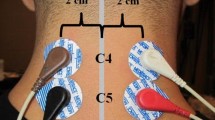Abstract
Fatigue is often associated with increased clumsiness. One possible explanation for this is that the proprioceptive signals from receptors in and around muscles change during muscle fatigue. Thirteen human subjects were tested for their ability to match the elbow angle of one arm with the contralateral arm, before and after a fatiguing contraction of one arm. Contractile fatigue was induced by a series of maximal voluntary contractions of the elbow flexors of the dominant arm. While fatigue of either the target arm or the matching arm usually changed the ability of individual subjects to match arm position, this effect varied markedly from one subject to another and no consistent pattern was discerned. In particular, there was no reciprocal change when the fatigued arm was the matching arm compared with when the nonfatigued arm was the matching arm. The absence of a consistent reciprocal effect indicates that the fatigue-related changes in the ability to match arm position are not solely due to changes in proprioceptive signals and that central fatigue processes are probably involved.
Similar content being viewed by others
References
Al-Falahe NA, Nagaoka M, Vallbo AB (1990) Response profiles of human muscle afferents during active finger movements. Brain 113:325–346
Balestra C, Duchateau J, Hainaut K (1992) Effect of fatigue on the stretch reflex in a human muscle. Electroencephalogr Clin Neurophysiol 85:46–52
Christakos CN, Windhorst U (1986) Spindle gain increase during muscle unit fatigue. Brain Res 365:388–392
Clark FJ, Burgess RC, Chapin JW, Lipscomb WT (1985) Role of intramuscular receptors in the awareness of limb position. J Neurophysiol 54:1529–1540
Darling WG, Hayes KC (1983) Human servo responses to load disturbances in fatigued muscle. Brain Res 267:345–351
Goodwin GM, McCloskey DI, Matthews PBC (1972) The contribution of muscle afferents to kinaesthesia shown by vibration induced illusions of movement and by the effects of paralysing joint afferents. Brain 95:705–748
Hakkinen K, Komi PV (1983) Electromyographic and mechanical characteristics of human skeletal muscle during fatigue under voluntary and reflex conditions. Electroencephalogr Clin Neurophysiol 55:436–444
Kirsch RF, Rymer WZ (1987) Neural compensation of muscular fatigue: evidence for significant force regulation in man. J Neurophysiol 57:1893–1910
McCloskey DI (1973) Differences between the senses of movement and position shown by the effects of loading and vibration of muscles in man. Brain Res 63:119–131
McCloskey DI (1978) Kinesthetic sensibility. Physiol Rev 58:763–820
McCloskey DI, Macefield G, Gandevia SC, Burke D (1987) Sensing position and movements of the fingers. News Physiol Sci 2:226–230
Author information
Authors and Affiliations
Rights and permissions
About this article
Cite this article
Sharpe, M.H., Miles, T.S. Position sense at the elbow after fatiguing contractions. Exp Brain Res 94, 179–182 (1993). https://doi.org/10.1007/BF00230480
Received:
Accepted:
Issue Date:
DOI: https://doi.org/10.1007/BF00230480




